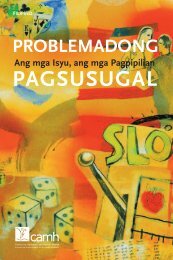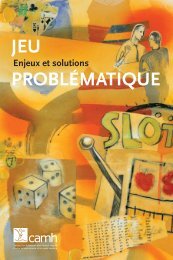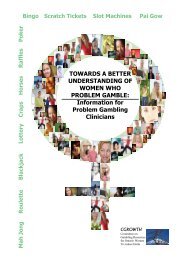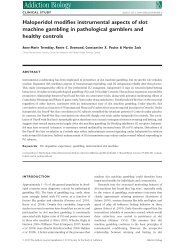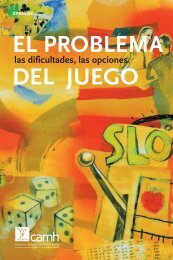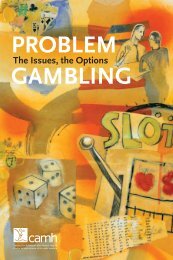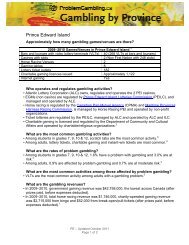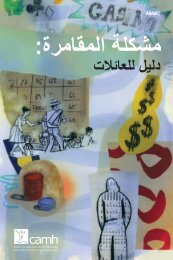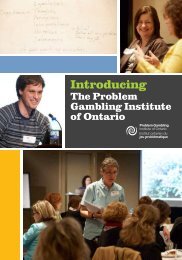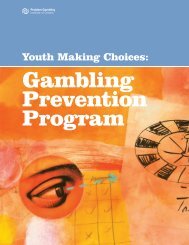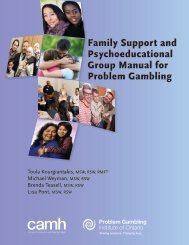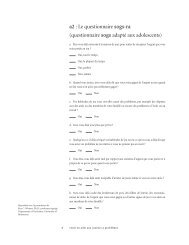Probability, Random Events, and the Mathematics of Gambling
Probability, Random Events, and the Mathematics of Gambling
Probability, Random Events, and the Mathematics of Gambling
You also want an ePaper? Increase the reach of your titles
YUMPU automatically turns print PDFs into web optimized ePapers that Google loves.
<strong>Probability</strong><br />
<strong>Probability</strong> is an estimate <strong>of</strong> <strong>the</strong> chance <strong>of</strong> winning divided by <strong>the</strong> total number <strong>of</strong> chances<br />
available. <strong>Probability</strong> is an ordinary fraction (e.g., 1/4) that can also be expressed as a<br />
percentage (e.g., 25%) or as a proportion between 0 <strong>and</strong> 1 (e.g., p = 0.25). If <strong>the</strong>re are four<br />
tickets in a draw <strong>and</strong> a player owns one <strong>of</strong> <strong>the</strong>m, his or her probability <strong>of</strong> winning is 1 in 4 or<br />
1/4 or 25% or p = 0.25.<br />
Odds<br />
Odds are ratios <strong>of</strong> a player’s chances <strong>of</strong> losing to his or her chances <strong>of</strong> winning, or <strong>the</strong><br />
average frequency <strong>of</strong> a loss to <strong>the</strong> average frequency <strong>of</strong> a win. If a player owns 1 <strong>of</strong> 4 tickets,<br />
his/her probability is 1 in 4 but his/her odds are 3 to 1. That means that <strong>the</strong>re are 3 chances <strong>of</strong><br />
losing <strong>and</strong> only 1 chance <strong>of</strong> winning. To convert odds to probability, take <strong>the</strong> player’s chance<br />
<strong>of</strong> winning, use it as <strong>the</strong> numerator <strong>and</strong> divide by <strong>the</strong> total number <strong>of</strong> chances, both winning<br />
<strong>and</strong> losing. For example, if <strong>the</strong> odds are 4 to 1, <strong>the</strong> probability equals 1 / (1 + 4) = 1/5 or 20%.<br />
Odds <strong>of</strong> 1 to 1 (50%) are called “evens,” <strong>and</strong> a payout <strong>of</strong> 1 to 1 is called “even money.”<br />
Epidemiologists use odds ratios to describe <strong>the</strong> risk for contracting a disease (e.g., a particular<br />
group <strong>of</strong> people might be 2.5 times more likely to have cancer than <strong>the</strong> rest <strong>of</strong> <strong>the</strong> population).<br />
In gambling, “odds” rarely mean <strong>the</strong> actual chance <strong>of</strong> a win. Most <strong>of</strong> <strong>the</strong> time, when <strong>the</strong> word<br />
“odds” is used, it refers to a subjective estimate <strong>of</strong> <strong>the</strong> odds ra<strong>the</strong>r than a precise ma<strong>the</strong>matical<br />
computation. Fur<strong>the</strong>rmore, <strong>the</strong> odds posted by a racetrack or bookie will not be <strong>the</strong> “true<br />
odds,” but <strong>the</strong> payout odds. The true odds are <strong>the</strong> actual chances <strong>of</strong> winning, whereas <strong>the</strong><br />
payout odds are <strong>the</strong> ratio <strong>of</strong> payout for each unit bet. A favourite horse might be quoted at<br />
odds <strong>of</strong> 2 to 1, which ma<strong>the</strong>matically would represent a probability <strong>of</strong> 33.3%, but in this case<br />
<strong>the</strong> actual meaning is that <strong>the</strong> track estimates that it will pay $2 pr<strong>of</strong>it for every $1 bet. A long<br />
shot (a horse with a low probability <strong>of</strong> winning) might be quoted at 18 to 1 (a ma<strong>the</strong>matical<br />
probability <strong>of</strong> 5.3%), but <strong>the</strong>se odds do not reflect <strong>the</strong> probability that <strong>the</strong> horse will win, <strong>the</strong>y<br />
mean only that <strong>the</strong> payout for a win will be $18 pr<strong>of</strong>it for every $1 bet. When a punter says<br />
“those are good odds,” he or she is essentially saying that <strong>the</strong> payout odds compensate for <strong>the</strong><br />
true odds against a horse winning. The true odds <strong>of</strong> a horse are actually unknown, but most<br />
<strong>of</strong>ten <strong>the</strong> true odds against a horse winning are longer (a lower chance <strong>of</strong> a win) than <strong>the</strong><br />
payout odds (e.g., payout odds = 3 to 1; true odds = 5 to 1). The posted odds <strong>of</strong> a horse<br />
actually overestimate <strong>the</strong> horse’s chance <strong>of</strong> winning to ensure that <strong>the</strong> punter is underpaid for<br />
a win.<br />
Equally Likely Outcomes<br />
Central to probability is <strong>the</strong> idea <strong>of</strong> equally likely outcomes (Stewart, 1989). Each side <strong>of</strong> a<br />
die or coin is equally likely to come up. <strong>Probability</strong>, however, does not always seem to be<br />
6




